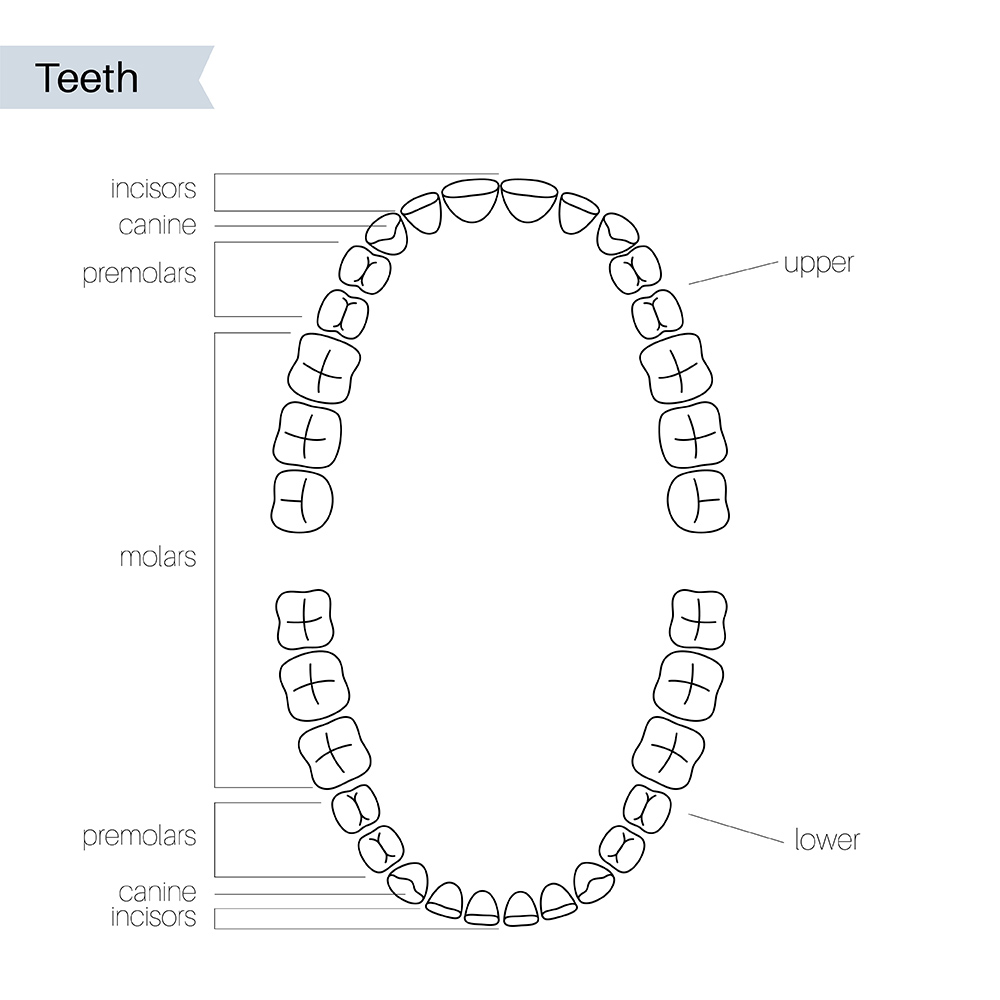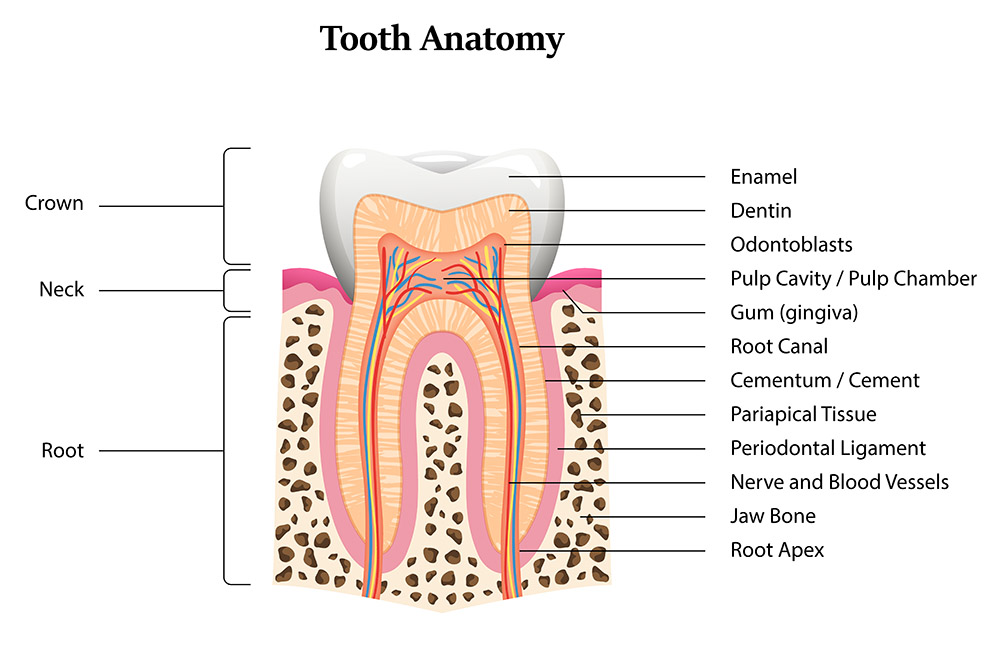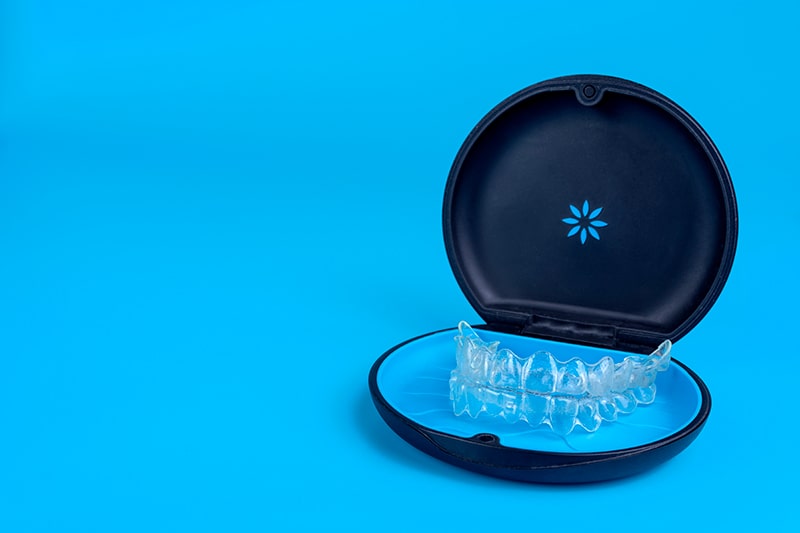Types of teeth:
Most adults begin adulthood with 32 teeth, not including their wisdom teeth. There are four different types of teeth, and each one affects how you eat, drink, and speak.
Incisors: You can cut up food with the aid of these chisel-shaped teeth.
Canines: You can tear and grasp food with these pointed teeth.
Premolars: You can crush and break food with the help of the two points on each premolar.
Molars: You can chew and grind food thanks to the numerous points on the top surface of these teeth.
Canines: You can tear and grasp food with these pointed teeth.
Premolars: You can crush and break food with the help of the two points on each premolar.
Molars: You can chew and grind food thanks to the numerous points on the top surface of these teeth.

Learn more about the anatomy, structure, and conditions that might impact your teeth as you continue reading. We’ll also offer some advice on dental health.
Structure and function
ROOT
The portion of the tooth that extends into the bone and maintains the tooth in place is known as the root. It covers about two-thirds of the tooth.
It is made up of various parts:
Root canal: A root canal is a pulp-filled channel.
Cementum: This bone-like substance, which is also known as cement, covers the tooth’s root. It is joined to the periodontal ligament.
Periodontal ligament: Collagen fibres and connective tissue make up the periodontal ligament. It is made up of blood vessels and nerves. The periodontal ligament joins the teeth to the tooth sockets along with the cementum.
Nerves and blood vessels: Blood vessels provide nourishment to the periodontal ligament, and nerves help regulate the force with which you chew.
Jaw bone: The jaw bone, also known as the alveolar bone, is the bone that contains the tooth sockets and encloses the roots of the teeth, holding the teeth in place.
It is made up of various parts:
Root canal: A root canal is a pulp-filled channel.
Cementum: This bone-like substance, which is also known as cement, covers the tooth’s root. It is joined to the periodontal ligament.
Periodontal ligament: Collagen fibres and connective tissue make up the periodontal ligament. It is made up of blood vessels and nerves. The periodontal ligament joins the teeth to the tooth sockets along with the cementum.
Nerves and blood vessels: Blood vessels provide nourishment to the periodontal ligament, and nerves help regulate the force with which you chew.
Jaw bone: The jaw bone, also known as the alveolar bone, is the bone that contains the tooth sockets and encloses the roots of the teeth, holding the teeth in place.
NECK
The area between the crown and root is known as the neck, or dental cervix. It creates the boundary between the enamel and the cementum, which covers the root.
It has three main parts:
Gums: The fleshy, pink connective tissue that connects the cementum and the tooth’s neck is known as the gums (also known as gingiva).
Pulp:The tooth’s innermost layer is called the pulp. It is composed of nerve tissue and microscopic blood vessels.
Pulp cavity: The area inside the crown that houses the pulp is known as the “pulp cavity“ or “pulp chamber.“
It has three main parts:
Gums: The fleshy, pink connective tissue that connects the cementum and the tooth’s neck is known as the gums (also known as gingiva).
Pulp:The tooth’s innermost layer is called the pulp. It is composed of nerve tissue and microscopic blood vessels.
Pulp cavity: The area inside the crown that houses the pulp is known as the “pulp cavity“ or “pulp chamber.“
CROWN
The part of a tooth that is visible is called the crown.
It contains three parts:
Anatomical crown: This is the top of a tooth. A tooth’s crown is typically the only visible portion.
Enamel: This is the tooth’s outermost layer. It helps shield teeth from bacteria because it is the body’s toughest tissue. Additionally, it gives your teeth strength so they can endure the force of chewing.
Dentin: Just beneath the enamel is a layer of mineralized tissue called dentin. It runs from the crown to the neck and root. It shields teeth from both heat and cold.
It contains three parts:
Anatomical crown: This is the top of a tooth. A tooth’s crown is typically the only visible portion.
Enamel: This is the tooth’s outermost layer. It helps shield teeth from bacteria because it is the body’s toughest tissue. Additionally, it gives your teeth strength so they can endure the force of chewing.
Dentin: Just beneath the enamel is a layer of mineralized tissue called dentin. It runs from the crown to the neck and root. It shields teeth from both heat and cold.

Common Tooth Conditions:
Your teeth carry out numerous tasks each day, which leaves them prone to a number of diseases.
Cavities:
Tooth cavities are tiny holes formed by bacterial and acid accumulation on the surface of a tooth. If they aren’t treated, they may penetrate a tooth’s enamel all the way to the pulp. Cavities may result in discomfort, sensitivity to heat and cold, infection, or tooth loss.
Pulpitis:
An untreated cavity is frequently the cause of pulpitis, which is pulp inflammation. The primary
symptoms are severe pain and sensitivity in the tooth that is damaged. It can eventually cause an infection, resulting in an abscess in the tooth’s root.
Periodontal disease:
Periodontal disease is also known as gum disease. It is a gum infection. Red, puffy, bleeding, or receding gums are all common symptoms. It can also result in bad breath, pain, sensitivity, and tooth loss. Your risk of gum disease is increased by smoking, taking certain drugs, and having bad oral health.
Abscess:
A bacterial infection results in a pus-filled pocket called a tooth abscess. It may result in tooth discomfort that goes to your jaw, ear, or neck. Other signs of an abscess include sensitive teeth, a fever, sore or swollen lymph nodes, and swelling of the face or cheeks. If you suspect a dental abscess, consult a dentist or physician right away. If the infection is not treated, it may spread to your brain or sinuses.
Tooth erosion:
Tooth erosion is the breakdown and loss of enamel caused by acid or abrasion. It may be brought on by acidic meals and beverages. It can also be brought on by stomach acid from gastrointestinal problems like acid reflux. Long-term dry mouth can also produce friction, which can damage teeth. Pain, sensitivity, and discoloration are typical indicators of tooth erosion.
Tooth impaction:
Tooth impaction occurs when there is insufficient space for a new tooth to develop, usually as a result of overcrowding. It frequently happens with wisdom teeth, but it can also happen when a baby tooth falls out before the permanent tooth is prepared to erupt.
Cavities:
Tooth cavities are tiny holes formed by bacterial and acid accumulation on the surface of a tooth. If they aren’t treated, they may penetrate a tooth’s enamel all the way to the pulp. Cavities may result in discomfort, sensitivity to heat and cold, infection, or tooth loss.
Pulpitis:
An untreated cavity is frequently the cause of pulpitis, which is pulp inflammation. The primary
symptoms are severe pain and sensitivity in the tooth that is damaged. It can eventually cause an infection, resulting in an abscess in the tooth’s root.
Periodontal disease:
Periodontal disease is also known as gum disease. It is a gum infection. Red, puffy, bleeding, or receding gums are all common symptoms. It can also result in bad breath, pain, sensitivity, and tooth loss. Your risk of gum disease is increased by smoking, taking certain drugs, and having bad oral health.
Abscess:
A bacterial infection results in a pus-filled pocket called a tooth abscess. It may result in tooth discomfort that goes to your jaw, ear, or neck. Other signs of an abscess include sensitive teeth, a fever, sore or swollen lymph nodes, and swelling of the face or cheeks. If you suspect a dental abscess, consult a dentist or physician right away. If the infection is not treated, it may spread to your brain or sinuses.
Tooth erosion:
Tooth erosion is the breakdown and loss of enamel caused by acid or abrasion. It may be brought on by acidic meals and beverages. It can also be brought on by stomach acid from gastrointestinal problems like acid reflux. Long-term dry mouth can also produce friction, which can damage teeth. Pain, sensitivity, and discoloration are typical indicators of tooth erosion.
Tooth impaction:
Tooth impaction occurs when there is insufficient space for a new tooth to develop, usually as a result of overcrowding. It frequently happens with wisdom teeth, but it can also happen when a baby tooth falls out before the permanent tooth is prepared to erupt.
Tips for Healthy Teeth:
By taking good care of your teeth, you can prevent numerous dental diseases. Follow these tips to maintain a strong, healthy mouth:
- Brush your teeth twice a day using fluoride toothpaste.
- Floss between your teeth once a day
- Replace your toothbrush every three months
- Limit your intake of sugary foods and drinks
Have regular dental check-ups
Make sure to visit your dentist regularly. Do not postpone getting checked out. Early detection of problems may make them easier to treat.
If issues are not resolved, they may result in damage that is more difficult or even impossible to fix.
If issues are not resolved, they may result in damage that is more difficult or even impossible to fix.




